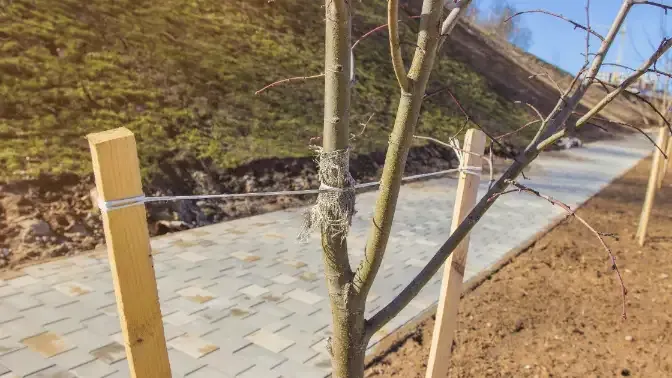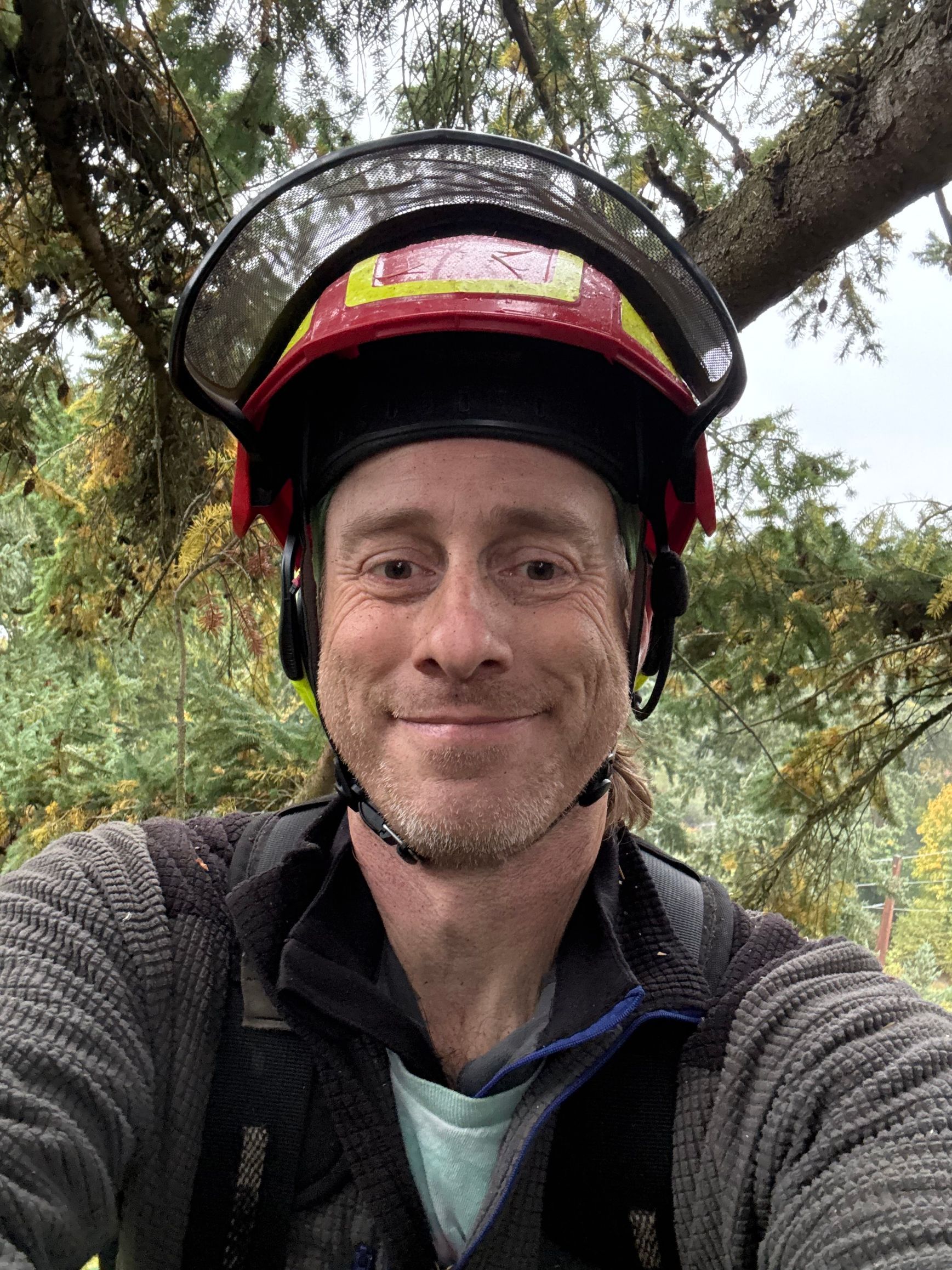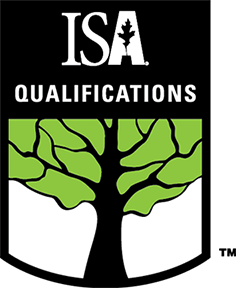How Long Should a Tree be Braced at Seattle, Washington
Written By: Eric Ledford
ISA Certified Arborist – PN-9290A
ISA Qualified Tree Risk Assessor (TRAQ)

Young and newly-planted trees need a little support until they’ve become established in their new home. Generally, stakes and braces should remain in place for no longer than two years.
To test the security of your young tree, shake it vigorously every so often. If the root ball is secure, remove the bracing.
Why Do We Brace Young Trees?
Staking newly planted and young trees provide them with
support
while their roots establish when done correctly, BUT it is not always necessary.
Done incorrectly, staking and bracing a young tree can weaken it by not allowing it to move with the wind and develop a robust root system and trunk or by girdling the tree.
Your newly planted trees may require cabling if:
- Their root systems are too small to support the tree’s stem, branches, and leaves
- The stem bends easily and to the extreme when not supported.
- They are exposed to severe wind with no shelter, which will cause them to be uprooted without support.
- They are in an area that leaves them vulnerable to vandals and passersby who uproot or damage unprotected trees.
A tree care specialist can help you determine if your young tree needs staking and cabling and can provide it with the support system it needs.
How To Brace A Young Or Newly-Planted Tree
If you determine that your young tree needs staking and cabling to help it establish itself successfully, be sure to use broad and flexible cabling around the stem to prevent
girdling or damaging the trunk.
Install the staking or guying attachments when you plant and leave them in place for
one growing season.
Staking Materials
- Staking and cabling materials vary depending on the size of the tree and the situation.
- For trees shorter than 10 to 12 feet, 2” X 2” wooden stakes work well. Be sure the stakes are below the canopy to prevent rubbing and damage to the branches and leaves.
- If high winds are an issue, use metal fence stakes around the tree.
- If the tree stem is larger than 4 inches in diameter, guying anchors pounded deep into the ground and tethered are more effective than tall stakes.
Regardless of the type of staking system you use,
wire, rope, or metal cable must never come into contact with the tree stem. Use smooth, broad
materials with flexibility when wrapping the stem, such as
- Burlap
- Old bicycle inner tube
- Strips of carpet
- Nylon stocking
- Wide canvas strapping
- Tree cabling kits purchased from a reputable tree care supply company or installed by a tree care specialist or arborist
How To Stake Your Tree
- When it comes to staking your tree, less is more. Generally, 1 stake should be sufficient. Place the state upwind from the prevailing summer wind. If high winds pose a threat, install 2 stakes running parallel to the prevailing winds.
- Drive the stake into the ground along the outside edge of the planting hole, so it’s safely outside the root system but inside the mulching area.
NOTE:
If you are guying to straighten a windblown tree, use 3 stakes placed evenly around the tree in a triangle with 1 stake upwind.
- Never place guying anchors or stakes outside the planting area. They pose a tripping hazard if they are too far from the tree.
How To Cable Young Trees
- If your young tree is staked, place the wide, flexible stem attachment material 1/3 to 2/3 of the way up the stem between the ground and the first branches.
- For guying trees with anchors, place the stem attachment in the area just above the first set of branches on the canopy. This provides the most stability to the entire tree when it's windy.
- Attach the cabling to the stakes or anchors and stem attachment loosely to allow the tree to move. Trees need to move, and the swaying during windy periods encourages root system establishment, flexible strength, and stem diameter growth.
- Use a figure 8 pattern when wrapping the stem (unless using store-bought systems)
Tightly cabled trees may grow tall and straight, but their stems will stay thin and weak.
How Long Should We Keep A Young Tree Staked?
A young tree should only be staked for 6 months to 2 years maximum and tested for stability and strength after the first growing season and every season after that.
How To Tell If You Can Remove The Support System From Your Tree
- Remove the stem attachments in the fall if you planted the tree in the spring or the previous fall.
- Shake the tree vigorously.
- If the root system still moves in the soil or the stem bends too much and easily, reattach the cabling and stem attachments loosely and leave them on for another season.
- If the root system is firmly established and the stem doesn’t bend excessively, remove the stakes and allow your tree to thrive on its own.
If you are unsure whether you can remove your support system, have a tree service provide you with an evaluation.
How To Support Young Coniferous Trees
Young, newly planted coniferous trees are susceptible to wind sail when planted in areas that experience severe winds. To prevent bending, leaning, and breaking, attach the guying systems to the stems
2/3 of the way up the tree using the same methods as above.
For trees shorter than ten feet, a
tripod support system is recommended.
- Place three stakes evenly around the planting area perimeter and pound them deep into the ground. The stakes should be taller than the tree.
- Weave the stakes through the branches and tie them together at the top above the tree.
This method provides the support young evergreens need without the risk of guys and cables damaging their branches or needles.
If you are unsure whether your newly planted trees need bracing or how to do it correctly, talk to a local arborist or tree care company you trust.
As the
top-rated tree care company
in the Seattle area, we are happy to provide you with the tree support system and advice you need to help your young trees flourish. We have an arborist on staff who can help you determine if your trees require bracing and can give them the support system they need.
Sound Tree Care is a top-rated, licensed tree care company with a certified arborist on staff serving SeaTac, Seattle, and the surrounding communities. Registered with the City of Seattle and Burien, our tree care specialists can help you keep your trees healthy and strong with regular tree pruning, preventative maintenance, removal, and disease treatment services. Talk to us about your trees today!




